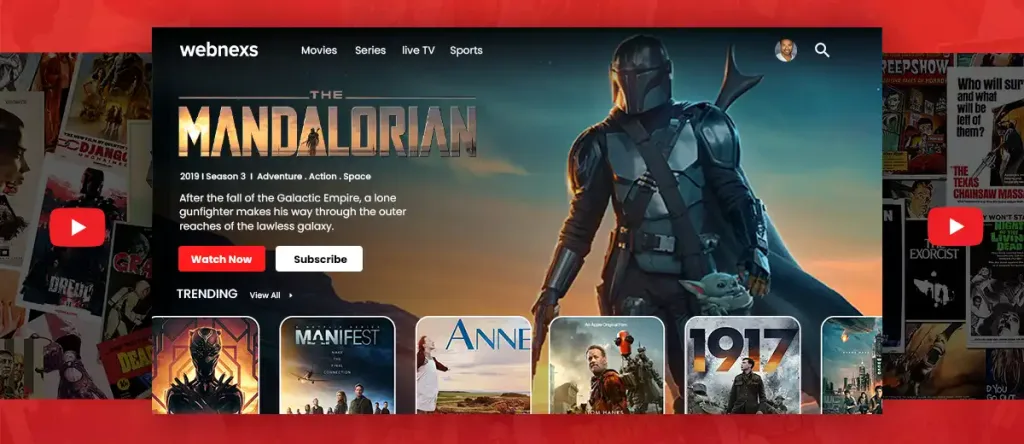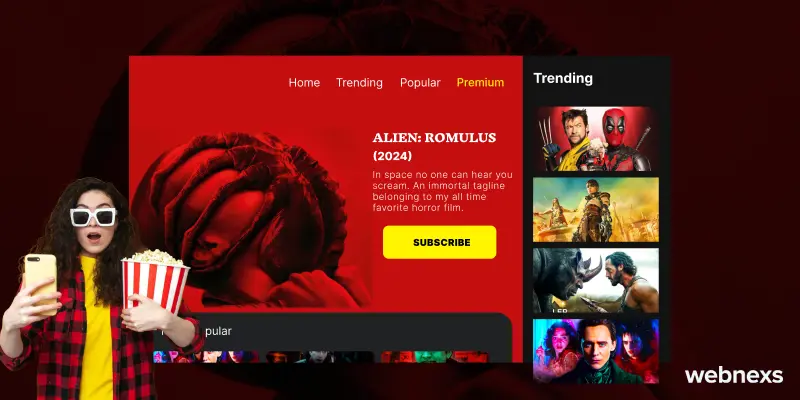If you’re considering launching a video on demand (VOD) platform for your business, you’re in good company.
The popularity of VOD platforms has exploded in recent years, with viewers increasingly turning to digital streaming services to access their favorite shows and movies.
In fact, the global Video On Demand market is projected to reach $159 billion by 2027, growing at a CAGR of 9.5% from 2021 to 2027, highlighting its massive potential.
However, with so many options available, it can be challenging to determine which platform is the best fit for your business.
That’s where this guide comes in. In this comprehensive resource, we’ll break down everything you need to know about Video On Demand platforms, from what they are and how they work to the different types of platforms available, and the fundamental aspects you must consider when choosing a video on demand platform the most suitable platform for your business’s growth.
What is Video on Demand Platform?
A Video on Demand platform is a digital streaming service that allows viewers to watch video content on demand. Unlike traditional television or cable, Video On Demand platforms enable users to watch programming whenever they want, wherever they want.
These platforms can take many forms, including subscription-based services, ad-supported platforms, and transactional services that allow users to rent or purchase individual titles.
In this section, we’ll delve deeper into the different types of video on demand platforms and their key features.
Types of Video on Demand Platforms
Video On Demand platforms can be broadly classified into three types: subscription-based services, ad-supported platforms, and transactional services.
Subscription-based Services
Subscription-based services require users to pay a monthly or yearly fee to access the platform’s content.
Examples of popular subscription-based services include Netflix, Hulu, and Amazon Prime Video.
Ad-Supported Platforms
Ad-supported platforms are free to use and generate revenue by showing ads to viewers.
Examples of popular ad-supported platforms include YouTube and Crackle.
Transactional Services
Transactional Video On Demand platforms allow users to rent or purchase individual titles.
Examples of popular transactional services include Apple iTunes and Google Play Movies.
The Stats of the Video-on-Demand Industry
The Video-on-Demand (VOD) business is changing fast due to improvements in streaming technologies, cloud computing, and user data analytics.
The global VOD market is worth $175 billion by 2025, and by the year 2030, the value is expected to be $280 billion, which will make the CAGR 9.5%.
Development is mainly a result of the rise of smart TVs, mobile streaming apps, and multi-platform OTT services.
Over 87% of the worldwide user base of the internet prefers streaming services monthly, with the first place being North America, followed by Asia Pacific, where the user penetration is getting higher seemingly every day due to cheap mobile internet.
In the U.S., a single person subscribes on average to 4.5 streaming services, which means the hunger for the variety of content is still growing and moving towards the direction of on-demand access.
From the point of view of technical infrastructure, CDN (Content Delivery Network) usage has hiked as much as 60% over the last three years, making low-latency streaming possible even in rural areas.
Furthermore, adaptive bitrate streaming (ABR) and cloud-based transcoding made it possible for the platforms to keep a consistent video quality level across all network conditions and the devices used.
In the field of revenue generation:
SVOD (Subscription Video-on-Demand) makes up over 53% of the global VOD revenue.
AVOD (Ad-supported VOD) is having a significant growth rate and might be a $66 billion business by 2027 on a global scale.
TVOD (Transactional VOD) is still popular among event sports and film premiere segments.
The demand for video DRM (Digital Rights Management) solutions has rapidly increased. Thus, more than 70% of VOD platforms introduce advanced encryption and access control mechanisms to avoid unwanted recording and unauthorized access.
In addition, AI-based recommendation engines, real-time analytics dashboards, and user behavior tracking are the new normal for the leading platforms, and they are the driving force behind the improvement of viewer experience and retention.
How to choosing a video on demand platforms
It is a fundamental decision to be made by any business to gain high-quality streaming content and thus, the choice of video on demand (VOD) platform is critical.
Since there are a host of options available, the first thing to do is an evaluation of your unique wants and objectives before you make the choice.
What you choose will control even matters like the users and the money you acquire, so make a wise selection.
This manual can aid you in going through the process of Video On Demand platform selection:
Understand Your Content and Audience:
The key to success is knowing the nature of the content you want to broadcast (e.g., movies, TV shows, e-learning videos) as well as the tastes of your target audience in order to pick the right one.
Thus, it would be simple to dissect features that match your needs.
Monetization Options:
Decide the means through which you want to generate revenue (SVOD, TVOD, AVOD, or Hybrid).
Make sure the platform is the one that supports your selected model thus enabling flexibility in the subscription management, pay per view, or ad-supported content.
Usability and Customization:
Search for not only a simple to use but also flexible platform as it is easy both to set it up and find your way through it.
Customization features like branding, UI design, and white-label solutions are key factors to make the experience enjoyable and smooth.
Video Quality and Streaming Performance:
Be sure the platform possesses high-quality video streaming (HD, 4K) and adaptive streaming, enabling video settings to switch as per the viewer’s internet speed.
It’s time to launch your VOD platform with Webnexs!
Key Features to Consider when Choosing a Video on Demand Platforms

When choosing a video on demand platform for your business, it’s essential to consider the key features that will impact the user experience and the success of your platform.
In this section, we’ll explore some of the most critical features to look for in a Video On Demand platform.
Content Management System (CMS)
The CMS is the backbone of any Video On Demand platform. It should be user-friendly and allow you to upload and organize your content easily.
The platform should also offer tools for metadata management, content scheduling, and content promotion.
Video Hosting
Video hosting is a crucial feature of any video on demand platform. Your platform should offer reliable video hosting with the ability to deliver high-quality video streaming to your audience.
Ensure that the platform you choose can handle the size and quality of your video files and can support various video formats.
Monetization
One of the primary reasons for launching a Video On Demand platform is to generate revenue.
Your platform should offer a range of monetization options such as pay-per-view, subscription-based models, advertising, and transactional video on demand (TVOD).
Make sure to choose a platform that aligns with your business goals and revenue model.
Analytics and Reporting
Analytics and reporting are essential to understand your audience and measure the performance of your Video On Demand service.
The platform should provide detailed insights into user behavior, engagement, and revenue generation.
It should offer reports on video views, revenue, and user demographics, which can help you make informed decisions about your content and marketing strategies.
Customization and Branding
Your video on demand platform should allow for customization and branding to create a unique experience for your audience.
You should be able to customize your player, website, and user interface to match your brand and meet your audience’s expectations.
Accelerate your streaming business growth! Start with the right VOD solution
How to Create a Video-on-Demand Website
Identify Your Niche and Target Audience
Before starting work on your VOD, it is essential that you can pinpoint your niche.
What do you intend to achieve, and what kind of content would you like your customers to see?
This strategy of downgrading your niche is very useful in the process of better knowing your audience and thus being able to provide them with the roots of their content.
Be keen on the likes, dislikes, and habits of your target audience: these can be their favorite programs, the type of their device, and their watching schedules and regions of residence.
This intelligence can effectively assist you in establishing live content and the features of the platform, which will keep them engrossed and will also be the basis of making the rest of your decisions for the platform.
Choose Your Monetization Model
First, consider the different ways you will earn money from your videos. Selecting the most suitable monetization model is the main factor in relating to both your business goals as well as the preferences of your audience.
Here are some approaches that have seemed quite effective:
- SVOD (Subscription Video on Demand) – Users subscribe and pay a monthly or yearly fee for infinite access to your content—a market strategy consistent with the one used by Netflix.
- TVOD (Transactional Video on Demand) – The audience pays per video, which means finding the option of renting or buying a single product. This is most suitable for exclusive or one-shot content.
- AVOD (Ad-based Video on Demand) – Viewers are able to watch the content without any charges, yet you as a content creator can earn by showing ads during playback, e.g., YouTube.
- Hybrid Model – This is a combination of at least two approaches (e.g., ad-free content with subscriptions with ads) to meet different user groups and raise the overall earnings potential.
After identifying the suitable monetization model, many current VOD platforms will let you:
- Incorporate worldwide payment gateways like Stripe, PayPal, or Razorpay
- Establish the units of the price that would nicely fit your offer
- Provide a free trial, promo codes, or bundled content to grow your customer base and increase user engagement
Your pricing strategy is of value, as it keeps your offering competitive and fully aligns with both the desired quality of your product and the expectations of your target customer base.
Start Making Your Video Content
Video production of a high standard is the central part of your VOD website.
Start with the pre-production stage, where you look at the subjects from the viewers’ standpoint, write scripts or create storyboards, and choose the shooting location and the equipment you will need.
You are not always required to set up a complete studio—nice lighting, a smartphone with a tripod, and a decent mic might be alright to start with.
Post-planning comes in after you have finalized everything. You will need a quiet and well-lit space for video recording. Make sure that your video is not shaky and the audio is of good quality.
To get a professional look, shoot your video in HD or 4 K.
Post-production is then the next process after you have finished with the recording. You will need editing software such as Adobe Premiere Pro or Final Cut Pro to edit your video.
Insert, in addition to your content, the title, the ending, subtitles, music, and branding elements such as your logo or your font, thus making it an updated task.
You should export your videos to/MP4 with an H. 264 codec to guarantee the realization of smoother streaming on all kinds of devices.
The most important principle is to provide your videos with an extremely visual look, which is at the same time very informative and engaging for your target audience.
Create Your VOD Website
Your VOD platform must have a website that is well-organized and compatible with all devices for the distribution of your content.
You increased brand awareness not only by creating a superior VOD platform but also by complementing it with a highly responsive, visually stunning official website.
The set of options includes using the advanced features of VOD website builders such as Webnexs, Flicknexs, Muvi, Vimeo OTT, or Uscreen with the templates, video players, monetization features, and CMS being already included, or create a site from scratch using WordPress or a certain coding framework.
Your website needs to be clean and user-friendly with the ability to navigate, mobile responsiveness, and have quick load times regardless of the direction you take.
Guests landing on your site should know what to expect from your content, and moving from one tab to another should be a click away.
So, the main pages that you need to have are a homepage with the most watched videos, a browse page with categories and filters, single video pages with descriptions and suggestions, login/signup pages, a payment or subscription page, and help/contact sections.
Make sure you represent yourself by using the same logos, branding, fonts, and colors in your site.
Most significantly, make itself a secure, scalable, and SEO-friendly (HTTPS) website, making it easier for the search engines to find you.
Choose a Reliable VOD Platform Provider
If you have your content and strategy prepared, then you require an efficient VOD platform provider who can manage video hosting, delivery, monetization, and security.
Some of the major providers, including Webnexs, Flicknexs, Uscreen, and Muvi, offer well-prepared OTT/VOD solutions integrated with video CMS (Content Management System), adaptive bitrate streaming, DRM (Digital Rights Management), payment integration, analytics, and app publishing options.
Decide on each provider according to their cost coverage, your technical requirements, scalability, and customer support.
By using a quality provider, you are at liberty to increase and broaden your video business to various devices and regions.
Launch Your Website and Start Promoting
Get your VOD website up and running and push it to the people who should see it.
Test all your site functionalities before the launch date, including video playback, sign-up flow, payment process, and compatibility with multiple devices.
Embark on a parallel path with a motivational marketing plan steered by various marketing strategies like social media, SEO, email marketing, PPC, and content marketing.
It is recommended that you prepare small video clips, a few trailers, or just the first few episodes to create a buzz and make the users convert.
It is also a good idea to put your platform on directories and marketplaces, place Google and social media ads, and be an active member of communities that fit your niche to grow your audience.
Track Performance and Improve Constantly
Launch a campaign that is not passive—it is of utmost importance to have the performance of your products regularly tracked through the built-in analytics dashboard, or with tools such as Google Analytics.
Monitor the number of views, watch time, drop-off rates, subscriber growth, revenue, and user engagement through videos.
Communicate directly with the users to get to know their likes and dislikes.
Base your decisions on the feedback received to enhance your content, price, user experience, and marketing strategy, thereby boosting your company’s performance in the future.
Regular updates and content drops will keep users coming back and help your platform grow sustainably.
Take the First Step Towards Your VOD Journey.
Webnexs – A Leading Online Video Platform to Launch Your VOD Website
Webnexs is a powerful and flexible Online Video Platform (OVP) built to support business owners, content creators, and enterprises in creating, managing, and monetizing their own Video on Demand (VOD) websites.
Designed with a high-tech stack and scalable architecture, Webnexs is ideal for a wide range of use cases—from educational streaming and entertainment hubs to sports training portals and more.
What sets Webnexs apart is its end-to-end support for video delivery. From cloud-based video transcoding and adaptive bitrate streaming to seamless playback across devices and varying network speeds, everything is built right into the platform—no third-party tools required.
With global CDN support, your content is delivered to audiences worldwide with low latency and zero buffering, ensuring a top-notch viewing experience.
Security is another cornerstone of Webnexs. It offers robust features like:
- Digital Rights Management (DRM)
- AES encryption
- Geo-blocking
- Token-based access control
These tools help protect your video content from piracy and unauthorized access.
When it comes to monetization, Webnexs gives you complete control. Choose from SVOD, TVOD, AVOD, or even a hybrid model to maximize your revenue—tailored to your audience and business goals.
Key Features of Webnexs:
- Advanced video analytics for performance insights
- AI-powered content recommendations
- Support for multiple devices & OTT apps (Android TV, Fire TV, Roku)
- Easy-to-manage branding and customization
- A developer-friendly CMS with flexible design and API access
Whether you’re a startup, content creator, or an enterprise, Webnexs simplifies your VOD platform launch—no coding required. Its ease of use, robust infrastructure, and scalable options make it one of the most reliable choices in the industry today.
Conclusion
Launching a successful video on demand platforms needs a significant investment of time, resources, and expertise.
However, with the right monetization options, high-quality content, and effective promotion, it is possible to build a successful platform that generates revenue and attracts a large audience. By considering the top VOD.




6 Responses
Thank you for your sharing. I am worried that I lack creative ideas. It is your article that makes me full of hope. Thank you.
Great blog! Clear, concise, and very informative about Video On Demand platforms. Perfect for anyone looking to understand the basics. Thanks for sharing!
I really enjoyed reading this blog. It’s concise, well-structured, and packed with valuable information.
Great job explaining the basics of Video On Demand platforms! The content is both engaging and informative.
A very informative read on video on demand platforms. The monetization tips are practical and easy to understand. Perfect for those planning to launch a platform. The examples given really help visualize the process. It’s a useful resource for creators and entrepreneurs alike.
Wow, fantastic weblog layout! How long have you been blogging? You make blogging look easy. The whole look of your website is great, especially the content on video on demand platforms!